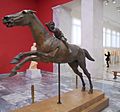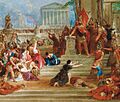Achaean War facts for kids
Quick facts for kids Achaean War |
|||||||||
|---|---|---|---|---|---|---|---|---|---|
| Part of the Macedonian wars | |||||||||
|
|||||||||
| Belligerents | |||||||||
| Roman Republic | Achaean League | ||||||||
| Commanders and leaders | |||||||||
| Metellus Macedonicus Lucius Mummius Achaicus |
Critolaos Diaeus |
||||||||
The Achaean War of 146 BC was a conflict between the powerful Roman Republic and the Achaean League. The Achaean League was a group of Greek city-states, mainly from the Peloponnese region. This war was the final step in Rome's takeover of mainland Greece. It happened right after the Fourth Macedonian War.
Rome and Achaea had been allies for about 50 years. They had worked together since the Second Macedonian War. However, tensions grew between them over time. Rome wanted to limit Achaea's power in the region. Achaea also wanted to include Sparta in its league, which Rome didn't like. After the Third Macedonian War, Rome took many Achaean citizens as hostages. This made relations even worse.
In 148 BC, Achaea defeated Sparta and brought it under its control. Rome tried to stop Achaea's expansion, but talks failed. This led to war. Rome quickly defeated the Achaean army near Scarpheia. Then, the Romans marched to Corinth, the Achaean capital. They defeated the remaining Achaean forces and completely destroyed the city. This happened in the same year Rome destroyed Carthage.
The Achaean War marked the end of Greek independence. It also began direct Roman rule over Greece. This period also saw a big cultural change in Rome. Many Greek artworks, ideas, and enslaved people came to Rome. This helped create the Greco-Roman culture we know today.
Contents
Why Did the War Happen?
Rome and the Achaean League used to be friends. They shared similar beliefs and fought together in earlier wars. But over time, political problems grew within Achaea. Two main groups formed. One group, led by Philopoemen and Lycortas, wanted Achaea to make its own decisions. The other group, led by Aristaenus and Diophanes, believed Achaea should always follow Rome's lead.
Achaea also faced problems from within. The city of Messene left the Achaean League. There were also ongoing arguments with Sparta about its role in the League. These issues led Rome to get more involved in Greek affairs. For example, in 184 BC, a Roman official named Appius Claudius was sent to settle a dispute between Sparta and Achaea.
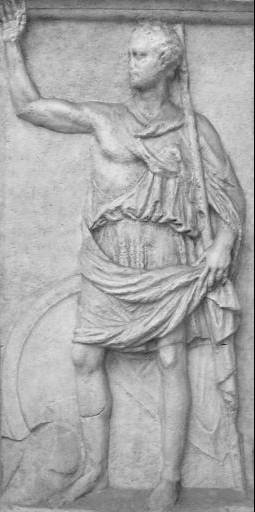
Rome took thousands of Achaean citizens as hostages during the Third Macedonian War. This was to make sure Achaea stayed loyal. This act caused a lot of anger in Greece. It also led to many diplomatic arguments between Achaea and Rome. Achaea sent five groups of representatives to Rome to ask for the hostages back. But Rome refused. This showed how much more powerful Rome was. This disagreement eventually led to the Achaean War.
Steps Leading to Conflict
Achaean politics played a big role in starting the war. Two popular leaders, Critolaos and Diaeus, were elected. They proposed new economic plans. These plans aimed to help the poor by reducing their debts. They also planned to free enslaved people born in Achaea. These ideas made many common people support a fight against Rome.
Around this time, a rebellion started in Macedon during the Fourth Macedonian War. This might have given Achaea hope. They thought Rome might be too busy with the Third Punic War in the west to deal with a Greek uprising.
Rome's foreign policy in Greece also changed. After the Third Macedonian War, Rome wanted to break up large Greek groups. They divided Macedon into smaller regions. Rome also tried to make cities leave the Achaean League. The historian Pausanias wrote that Roman officials treated the Greeks with great arrogance.
In 150 BC, fighting broke out again between Sparta and the Achaean League. Sparta wanted more independence and rebelled when it was denied. The Achaeans quickly defeated Sparta. However, the Achaean general in 149 BC, Damocritus, did not continue the attack. This might have been due to Roman pressure or a desire for peace. People were unhappy with this, and he was sent away.
In 148 BC, Diaeus was elected general. He promised to be aggressive and unite the League. He quickly attacked Sparta and brought it under control by the end of the year. During this time, Rome did not get involved much. They were busy with the Fourth Macedonian War and the Third Punic War.
But in 147 BC, Rome sent a new group of officials. They were led by Lucius Aurelius Orestes. Orestes tried to force the Achaean League to shrink back to its original, smaller size. This would have greatly weakened it. This might have been a negotiating tactic, but it angered the Achaeans. The Roman officials were almost attacked by a mob.
Another Roman attempt at peace, led by Sextus Julius Caesar, also failed. The Achaeans were furious with Rome's actions. They stirred up public anger and declared war on Sparta. Critolaos was elected as the League's general. Historians debate if this declaration against Sparta also meant war against Rome, or if Rome reacted to it.
The War Begins
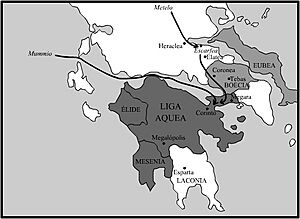
The Achaeans knew they were challenging a very powerful Rome. Rome had just conquered Macedon, a much stronger kingdom. Two Roman armies were sent to stop the Greek rebellion. One army came from Italy, led by Mummius, who was now a consul. The other army was led by praetor Quintus Caecilius Metellus Macedonicus. He had recently defeated the Macedonian rebels.
Critolaos was attacking the city of Heraclea in Trachis, which had rebelled from the League. He learned that Metellus was marching from Macedon to fight him. Critolaos retreated to Scarpheia. But Metellus caught up with him and won a major victory at the Battle of Scarpheia. After this, Metellus sent his army to rest for the winter. Critolaos died during or after the battle. He either drowned in the marshes or took his own life.
The defeat and death of Critolaos caused great fear in Greece. Some cities, like Elis and Messene, surrendered to the Romans. However, many parts of the League, especially Corinth, decided to keep fighting. They rallied around Diaeus, who became the new general. They raised new armies and took property and wealth to fund the war. Metellus then moved through Boeotia, capturing Thebes, which had been allied with Achaea. He offered peace to the League, but Diaeus refused. Diaeus also had politicians who wanted peace arrested or killed.
Mummius arrived with his army. He sent Metellus back to Macedon. Mummius then gathered all Roman forces, about 23,000 foot soldiers and 3,500 horsemen. He prepared to attack Corinth. Diaeus also gathered his forces, about 13,500 foot soldiers and 650 horsemen. After an early success in a small fight, Diaeus felt confident. He decided to fight the Romans directly.
In the Battle of Corinth, Diaeus's horsemen were quickly defeated by the Roman cavalry. This left his army's side open to attack. About 1,000 skilled Roman foot soldiers attacked, causing Diaeus's army to break and run.
The Destruction of Corinth
The remaining Achaean soldiers could have defended Corinth. But Diaeus left them and fled to Megalopolis, where he died after killing his wife. The Achaean soldiers and most people in Corinth lost hope. They fled the city, leaving it undefended. The Romans took control of the city three days after the battle. Mummius had waited, fearing a trap. Any remaining Greek resistance then surrendered.
The Roman consul Mummius granted freedom to all Greeks, except those from Corinth. In Corinth, the Romans killed all the adult men. They enslaved all the women and children. Then, they completely destroyed the city. This harsh action was likely ordered by the Senate. Some historians believe it was to remove a trade rival. According to Polybius, Mummius could not resist the pressure from those around him. Other historians say Mummius did not take any of the spoils for himself and praised his honesty.
Polybius also wrote that Roman soldiers were careless. They destroyed valuable artworks or treated them like toys. However, they did show respect for statues of Philopoemen. This was because of his fame and because he was an early ally of Rome in Greece. Mummius himself knew little about art. When sending precious statues and paintings to Italy, he warned the transporters that if they lost them, they would have to replace them with new ones. Like the destruction of Syracuse, the destruction of Corinth brought many Greek artworks into the Roman world. This further exposed Rome to Greek culture and helped create the Greco-Roman world.
Rome Organizes Greece
After the conquest, Mummius ordered the walls of all rebellious cities to be torn down. He also made all cities hand over their weapons and military gear.
Soon, ten Roman officials were sent to Achaea. They helped Mummius reorganize Greece. The Greeks had to pay war damages and taxes. All Greek leagues and political groups were broken up. Power was given to Greek leaders who supported Rome. Later, some financial relief was given, and some cities, like Athens and Sparta, gained some independence. Politically, the Greek states became part of the Roman province of Macedonia. However, Achaea became its own Roman province in 27 BC under Augustus.
What Happened Next?
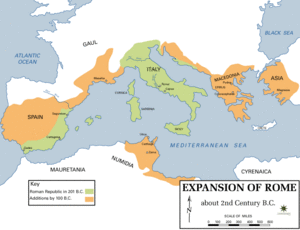
Mummius celebrated a great victory parade in Rome. He was given the special name Achaicus for his success in Greece. With the wealth from his Greek campaigns, he built a theater in Rome. It had better sound and seating, based on Greek designs. This was a big step forward in building entertainment venues.
The Achaean War marked the end of Greece's political freedom. It also began the end of the Hellenistic period. Pergamon, the last major power in the Aegean Sea, generally supported Rome. Its last king, Attalus III, left his kingdom to Rome in his will when he died in 133 BC. So, 70 years after Rome first got involved in Greek affairs, it controlled all of the classical Greek world. Rome had become the most powerful force in the Mediterranean Sea.
This takeover also marked the start of a new, Greco-Roman culture. Greek and Roman cultures mixed together. This process had begun a century earlier when Rome conquered Greek cities in Sicily.
Images for kids
-
Roman general Lucius Mummius Achaicus in The Sack of Corinth, by Thomas Allom (detail)



